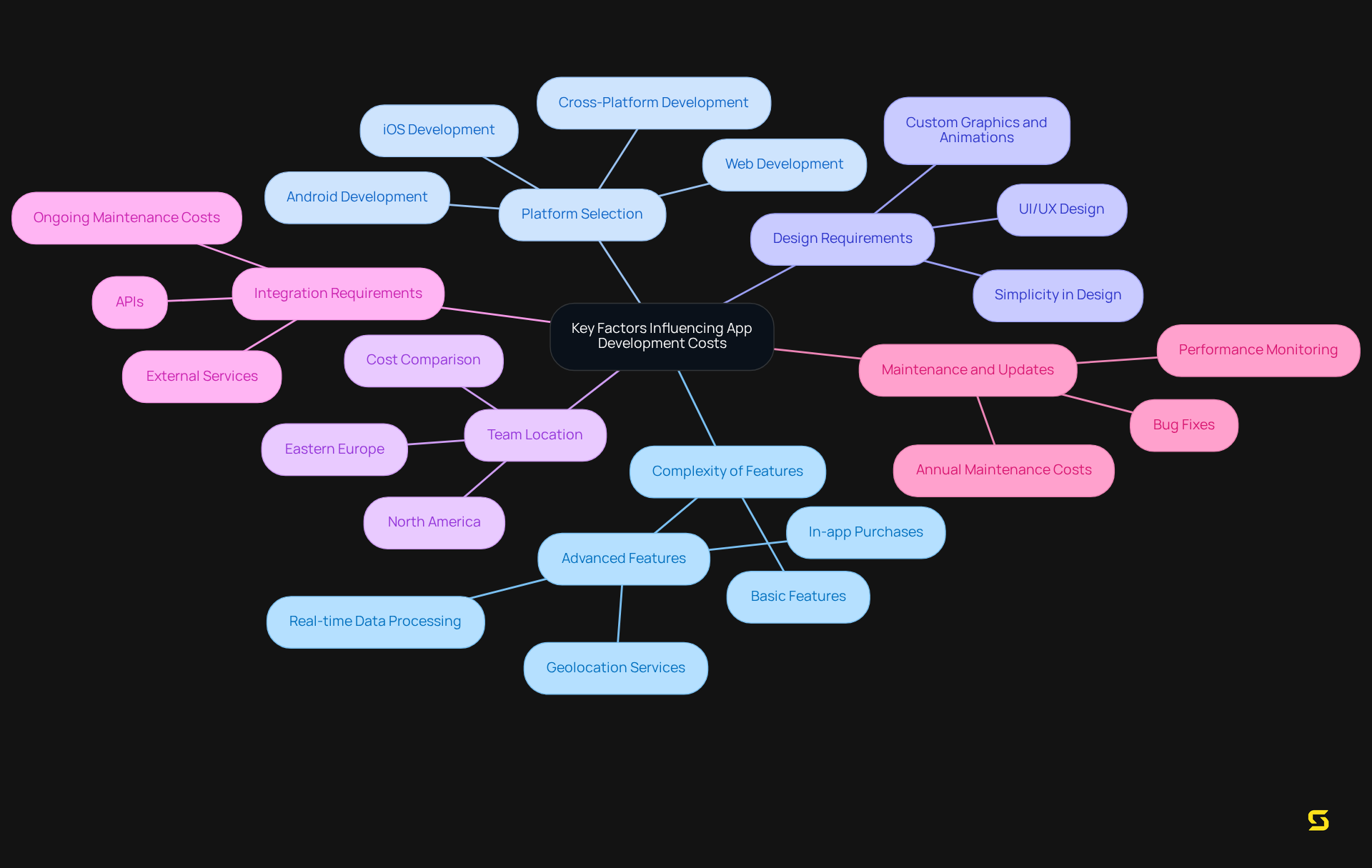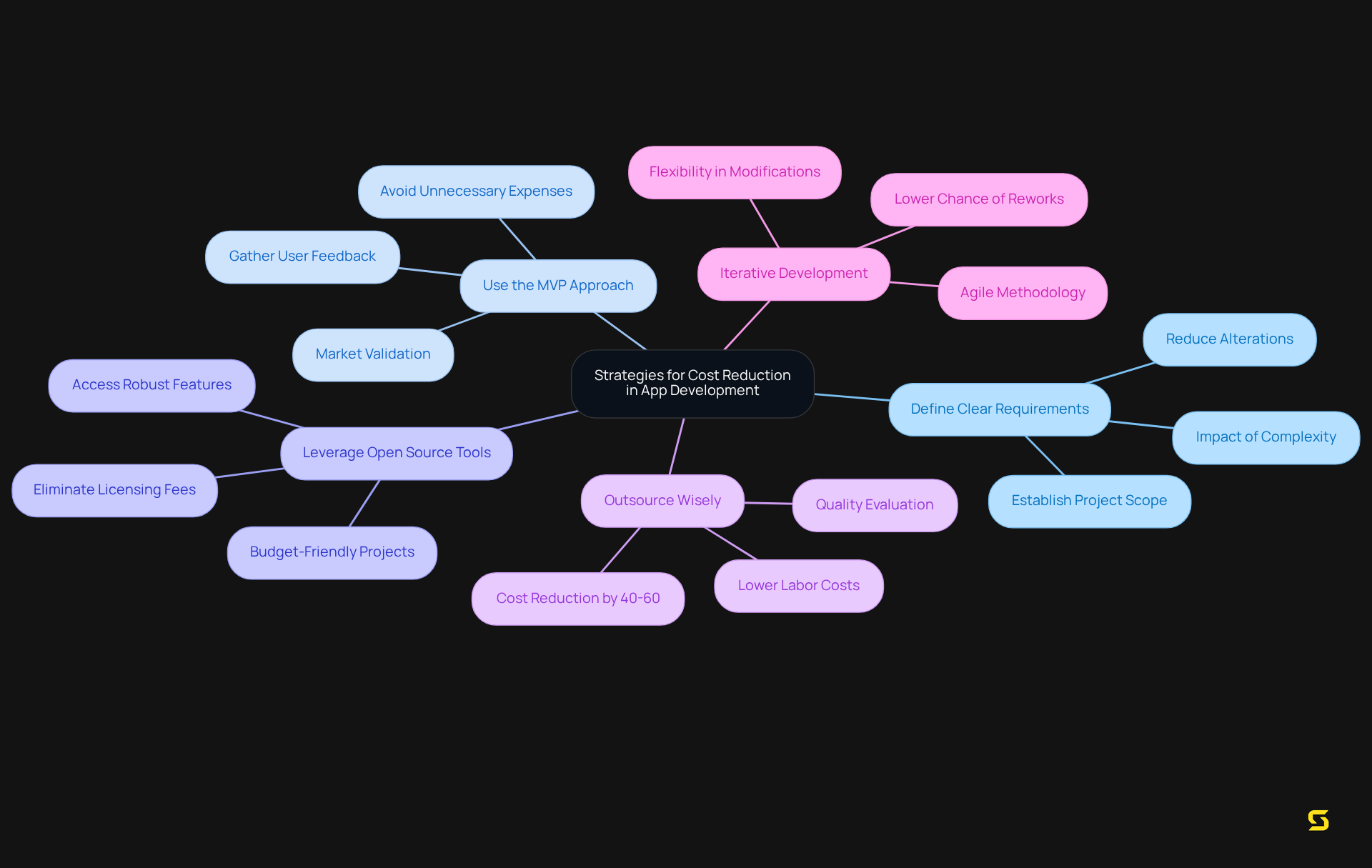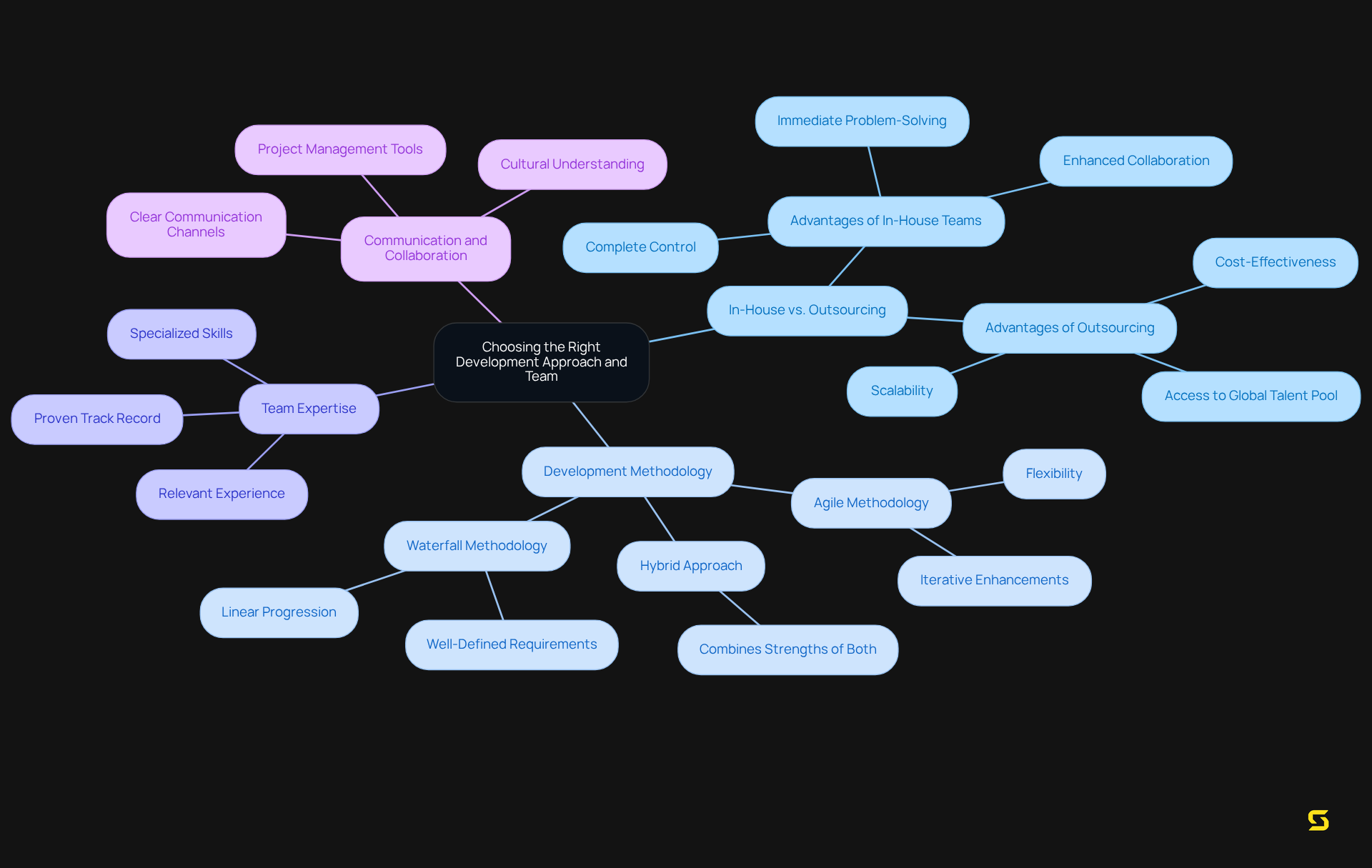Overview
Understanding the costs associated with app creation is essential for any successful project. Key factors such as:
- Feature complexity
- Platform selection
- Design requirements
- Team location
- Integration needs
- Ongoing maintenance
play a pivotal role in shaping the overall budget. These elements significantly influence financial planning, underscoring the importance of strategic planning and informed decision-making. By prioritizing these considerations, businesses can achieve more efficient resource allocation and effective cost management throughout the development process. Take control of your app development journey and ensure that every dollar spent contributes to your project's success.
Introduction
Understanding the financial landscape of app creation is essential for businesses aiming to navigate the competitive digital marketplace. The potential for costs to escalate—driven by factors such as feature complexity and team location—demands that companies strategically plan their budgets to avert pitfalls.
How can organizations ensure effective resource allocation while achieving their app development objectives? This article explores the critical elements that influence app development costs and presents actionable strategies for cost reduction, guiding businesses toward successful and financially sound app creation.
Key Factors Influencing App Development Costs
Several key factors significantly influence the app creation costs associated with development.
-
Complexity of Features: The intricacy of features, such as real-time data processing and advanced user interfaces, directly correlates with higher development costs. While fundamental aspects like user log-in and push notifications are crucial, expenses can rise significantly with more intricate features, such as geolocation services or in-app purchases.
-
Platform Selection: Creating for various platforms—iOS, Android, and web—can increase expenses due to the requirement for distinct coding languages and design modifications. However, cross-platform development can help mitigate app creation costs by utilizing a single codebase, ultimately saving both time and money.
-
Design Requirements: High-quality UI/UX design is essential for user engagement and can significantly influence app creation costs, particularly when custom graphics and animations are included. Maintaining a straightforward and practical design can assist in minimizing complexity and related expenses.
-
Team Location: The geographical position of the team is crucial in influencing labor expenses. For instance, hiring developers in Eastern Europe can be 40-60% cheaper than in North America, making it a cost-effective option for many businesses.
-
Integration Requirements: Applications needing integration with external services or APIs may lead to extra expenses due to the complexity involved. This includes ongoing maintenance for these integrations, which can range from $3,000 to $20,000 annually.
-
Maintenance and Updates: Ongoing support and updates are essential for app longevity and should be factored into the overall budget. Maintenance expenses usually total 15-25% of the initial app creation costs annually, encompassing bug fixes, updates, and performance monitoring.
Comprehending these factors enables companies to distribute resources efficiently and make informed choices regarding their app creation costs. As Mike Jackowski, co-founder of Asper Brothers, emphasizes, "Constructed with an external team, it enhances efficiency, reduces expenses, and grows alongside you." Additionally, Paul Jackowski, CEO of Asper Brothers, notes, "The breadth of this range underscores the importance of having a clear understanding of these costs, as it’s essential for efficient budgeting, setting timelines, and even investor relations." This highlights the significance of strategic planning and collaboration in navigating the complexities of application creation.

Cost Breakdown by Development Stage
The app development process unfolds through several key stages, each characterized by distinct costs that demand your attention:
-
Planning and Research: This foundational phase is critical, encompassing market research, user persona definition, and app functionality outlining. The costs of app creation typically range from $5,000 to $15,000, reflecting the depth of research required. Notably, most companies allocate between $5,000 and $10,000 for the Discovery stage, which accounts for about 10-15% of their total budget. This underscores its significance in setting realistic expectations for the project.
-
Design: UI/UX design is paramount for user engagement and satisfaction. The costs for app creation in this phase generally fall between $10,000 and $50,000, influenced by the complexity of the design and the number of screens involved. A well-executed design can significantly enhance user retention and overall app performance.
-
App creation costs are frequently the most considerable expense, varying from $20,000 to more than $200,000, depending on the app's features and the skills of the creation team. The intricacy of the app directly influences expenses, with more advanced features necessitating extra resources.
-
Testing: Quality assurance is vital to ensure the app operates smoothly. Testing expenses can range from $5,000 to $30,000, depending on the scope of testing needed to identify and resolve issues prior to launch.
-
Launch: The launch phase includes marketing and deployment expenses, typically ranging from $5,000 to $20,000. This investment is crucial for ensuring the app reaches its target audience effectively.
-
Maintenance: Post-launch support and updates are essential for keeping the app relevant and functional. Maintenance expenses typically represent 15-20% of the app creation costs each year, highlighting the necessity for continuous investment to tackle bugs, security updates, and feature enhancements.
Understanding these expense ranges and their implications is essential for efficient budgeting and resource distribution throughout the application creation journey.

Strategies for Cost Reduction in App Development
To effectively reduce app development costs, consider implementing the following strategies:
-
Define Clear Requirements: Establishing a well-defined project scope is crucial. This clarity reduces alterations during the creation process, potentially leading to higher expenses and project setbacks. The complexity of your app significantly impacts app creation costs, making it essential to outline your needs from the outset.
-
Use the MVP Approach: Beginning with a Minimum Viable Product (MVP) allows you to evaluate your idea in the market before committing to full-scale implementation. This approach has proven successful, enabling businesses to gather user feedback early, adapt quickly, and avoid unnecessary expenses. In 2025, the MVP strategy remains a cornerstone for startups, with many achieving validation and market fit through this method. As Evan Spiegel, CEO of Snapchat, stated, "People think building an app is expensive. What's really expensive is building the wrong app. Start with MVP, test, then invest."
-
Leverage Open Source Tools: Utilizing open-source libraries and frameworks can significantly reduce time and expenses. These tools not only provide robust features but also eliminate licensing fees, facilitating more budget-friendly projects.
-
Outsource Wisely: Consider outsourcing production to regions with lower labor costs, such as Eastern Europe or Asia. This strategy can reduce expenses by 40-60% without compromising quality. However, a comprehensive evaluation of groups is essential to ensure that the quality of work meets your standards.
-
Iterative Development: Embracing an agile methodology promotes flexibility and enables modifications throughout the creation process. This iterative method lowers the chance of expensive reworks by allowing teams to react efficiently to user input and evolving requirements.
By concentrating on these strategies, businesses can navigate the complexities of app creation while effectively managing app creation costs, ultimately leading to successful project outcomes.

Choosing the Right Development Approach and Team
When selecting a development approach and team, several critical factors must be considered:
-
In-House vs. Outsourcing: Weigh the advantages and disadvantages of building an in-house team against outsourcing to a development agency. Internal groups provide increased oversight of the creation process and foster improved cooperation among members. However, outsourcing often proves to be more economical, as it provides access to a global talent pool and specialized skills, which helps in lowering app creation costs compared to maintaining a full-time workforce. For instance, outsourcing can reduce app creation costs for companies by 60-70% by employing teams in countries with lower labor costs.
-
Development Methodology: Choose between agile, waterfall, or hybrid methodologies based on your project's specific requirements and your team's capabilities. Agile methodology is frequently favored for its flexibility and iterative nature, enabling teams to adapt quickly to changes and deliver incremental enhancements. Conversely, the waterfall model may be appropriate for projects with well-defined requirements and a linear progression. A hybrid approach, which combines both methodologies, can also be advantageous, allowing businesses to capitalize on the strengths of each.
-
Team Expertise: Ensure that the engineering team possesses relevant experience in the technologies and industries pertinent to your application. A team with a proven track record of successful projects can significantly enhance the likelihood of achieving your goals efficiently. For example, companies like FairMoney have successfully partnered with development agencies to enhance their offerings and decrease time-to-market.
-
Communication and Collaboration: Select a team that prioritizes clear communication and collaboration. Effective communication is essential for project efficiency and can mitigate potential misunderstandings, particularly when working with outsourced teams. Establishing robust communication channels and promoting cultural understanding can further enhance collaboration and project outcomes. Employing project management tools and setting clear expectations are practical strategies to overcome communication barriers.

Conclusion
Understanding the costs associated with app creation is essential for businesses aiming to navigate the complex landscape of mobile development. By grasping the various factors that influence these expenses—such as feature complexity, platform selection, and design requirements—companies can strategically allocate resources and make informed decisions. This knowledge empowers businesses to optimize their budgets and timelines effectively.
The article highlights several key arguments, including:
- The importance of defining clear project requirements
- Leveraging the Minimum Viable Product (MVP) approach
- Considering outsourcing to significantly reduce costs
Each development stage, from planning and design to launch and maintenance, carries its own financial implications that must be carefully managed to ensure the overall success of the project. Additionally, the choice of development methodology and team can greatly impact both the quality and cost of the final product.
Ultimately, these insights emphasize the necessity for businesses to approach app development with a strategic mindset. By implementing cost reduction strategies and fostering effective communication within development teams, organizations can not only save money but also enhance their chances of creating a successful app. In a competitive market, understanding and managing app creation costs is not just beneficial—it is essential for achieving long-term success and delivering value to users.
Frequently Asked Questions
What are the main factors that influence app development costs?
The main factors influencing app development costs include the complexity of features, platform selection, design requirements, team location, integration requirements, and ongoing maintenance and updates.
How does the complexity of features affect app development costs?
The complexity of features directly correlates with higher development costs. Basic features like user log-in and push notifications are less expensive, while intricate features such as geolocation services or in-app purchases significantly increase costs.
What impact does platform selection have on app development expenses?
Developing for multiple platforms (iOS, Android, and web) can increase expenses due to the need for different coding languages and design adjustments. Cross-platform development can help reduce costs by allowing the use of a single codebase.
Why are design requirements important in app development costs?
High-quality UI/UX design is crucial for user engagement and can significantly increase costs, especially when custom graphics and animations are involved. A straightforward design can help minimize complexity and expenses.
How does the geographical location of the development team affect costs?
The location of the development team can greatly influence labor expenses. For example, hiring developers in Eastern Europe can be 40-60% cheaper than in North America, making it a more cost-effective choice for many businesses.
What are integration requirements and how do they impact costs?
Integration requirements involve connecting the app with external services or APIs, which can lead to additional expenses due to the complexity involved. Ongoing maintenance for these integrations can cost between $3,000 to $20,000 annually.
What should be considered regarding maintenance and updates in app development?
Ongoing support and updates are essential for the app's longevity and should be included in the budget. Maintenance costs typically amount to 15-25% of the initial app creation costs annually, covering bug fixes, updates, and performance monitoring.
Why is understanding these factors important for companies?
Understanding these factors allows companies to allocate resources efficiently and make informed decisions about their app development costs, which is crucial for budgeting, setting timelines, and managing investor relations.





